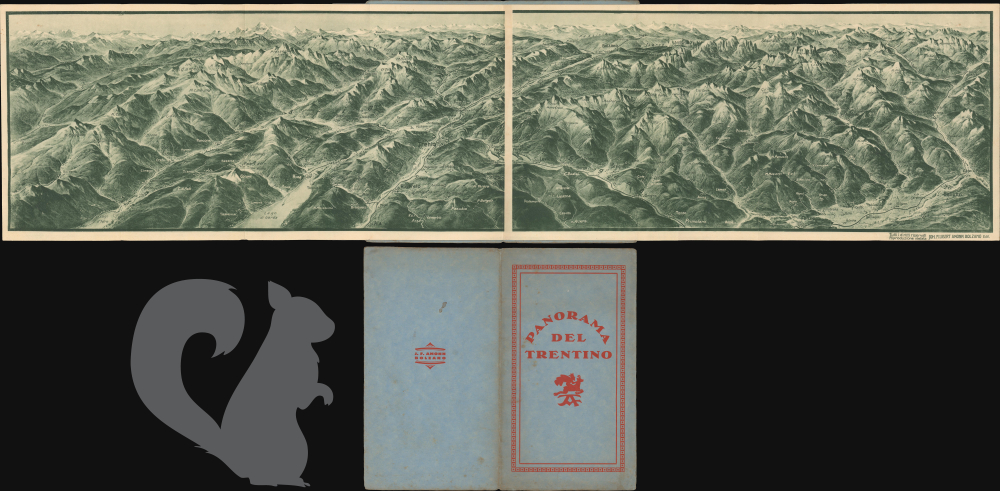Digital Image: 1930 Amonn Pictorial Panoramic View of Trentino-Alto Adige / Südtirol, Italy
Trentino-amonn-1930_d
Title
1930 (undated) 8 x 34.5 in (20.32 x 87.63 cm)
Description
FOR THE ORIGINAL ANTIQUE MAP, WITH HISTORICAL ANALYSIS, CLICK HERE.
Digital Map Information
Geographicus maintains an archive of high-resolution rare map scans. We scan our maps at 300 DPI or higher, with newer images being 600 DPI, (either TIFF or JPEG, depending on when the scan was done) which is most cases in suitable for enlargement and printing.
Delivery
Once you purchase our digital scan service, you will receive a download link via email - usually within seconds. Digital orders are delivered as ZIP files, an industry standard file compression protocol that any computer should be able to unpack. Some of our files are very large, and can take some time to download. Most files are saved into your computer's 'Downloads' folder. All delivery is electronic. No physical product is shipped.
Credit and Scope of Use
You can use your digial image any way you want! Our digital images are unrestricted by copyright and can be used, modified, and published freely. The textual description that accompanies the original antique map is not included in the sale of digital images and remains protected by copyright. That said, we put significant care and effort into scanning and editing these maps, and we’d appreciate a credit when possible. Should you wish to credit us, please use the following credit line:
Courtesy of Geographicus Rare Antique Maps (https://www.geographicus.com).
How Large Can I Print?
In general, at 300 DPI, you should at least be able to double the size of the actual image, more so with our 600 DPI images. So, if the original was 10 x 12 inches, you can print at 20 x 24 inches, without quality loss. If your display requirements can accommodate some loss in image quality, you can make it even larger. That being said, no quality of scan will allow you to blow up at 10 x 12 inch map to wall size without significant quality loss. For more information, it is best consult a printer or reprographics specialist.
Refunds
If the high resolution image you ordered is unavailable, we will fully refund your purchase. Otherwise, digital images scans are a service, not a tangible product, and cannot be returned or refunded once the download link is used.
Cartographer
Johann Filibert Amonn (fl. c. 1849-1891) is a still-extant grocer, hospitality company, and associated enterprises, including printing and stationery, based in Bolzano (Bozen), the capital city of the Italian region of Südtirol-Alto Adige. The company's origins date back to the opening of an inn in Bolzano in 1754 by Johann Michael Aman (the spelling later changed to Amonn), who later acquired two other hotels. In 1802, his son, Johann Jakob Amonn, obtained a trading license and opened a general store at the family's hotel on the Piazza Municipio, which is seen as the founding of the company. In 1836, Johann Carl Amonn took over the company, and in 1849, he passed it on to his son, Johann Filibert Amonn, who renamed the company J. F. Amonn, a name it continues to use today. Johann Filibert had no children but was assisted in the business by his younger brother, Arnold Secundus Amonn, who expanded into new ventures, especially postcards, stationery, and paper souvenirs (including maps and views) for tourists and hikers visiting the Italian Alps. Like Bolzano (Bozen) itself, the firm's output was often bilingual (Italian-German). In 1886, the company effectively divided its general store and printing businesses, and in 1891, the firm passed on to Emil Dominik Amonn, the nephew of Johann Filibert Amonn. Emil Dominik proved an adept businessman and expanded the company considerably, acquiring competitors, including the printing house Reigl and Co. In 1913, Emil Dominik Amonn died, and the business passed to his sons, Erich and Walter. However, as they were still adolescents, the company was managed by Emil's father-in-law, Josef Dalle Aste. All aspects of the business, particularly groceries and printing, continued to expand in the early 20th century, including the addition of a bookbindery and papermaking plant. In 1922, Erich and Walter, after serving in the First World War, took over management of the business, slightly changing the name of the printing house in 1925 to 'Joh. Fil. Amonn.' The company expanded further in the 1920s and 1930s, moving into the manufacture of radios and chemicals, becoming a joint stock company in 1935. The Second World War badly hurt the company, with German investors buying most of the company's stocks and shifting its focus to war material. Most of the company's facilities, including the flagship store on the Piazza Municipio in Bolzano, were severely damaged by Allied bombings. However, the company rebounded in the postwar period and garnered significant investment in the course of Italy's postwar economic miracle. With the company becoming too large to manage, it was formally divided in 1965, and today consists of four related but distinct enterprises, focusing on chemicals, hospitality, printing, and stationery. These companies have undergone multiple sales and restructurings, but they retain the name Amonn. More by this mapmaker...

